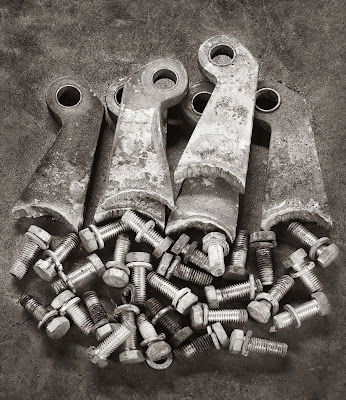
Here's a little trick I have found useful.
First, if I have worked on an image for some considerable time, perhaps cropping and changing and long since lost the original image, you can flatten the image, select all, then copy the image to the clipboard, then go to the history palette and scroll up to the original loaded image and select that. Now past the edited copy as a new layer on top of the original. If you add a white mask to the top layer (the edited version), you can then paint into the mask to reveal some of the original image if you need it.
Today I was converting some of my colour Indpendent Machinery images to black and white and in the image above, noted that the right hand widget blended too closely to the background with the filtering I'd chosen with my black and white adjustment layer (I'd used blue for the best overall effect).
I used the technique above to restore the colour version, added a new black and white conversion between the original colour image on the bottom and the edited version in bw on top. I turned off the top layer to reveal the full colour image from below and played with the filters till I had the best separation of that right hand widget - it turned out to be yellow filtering.
I then painted black into the mask of the top layer, revealing the yellow filtering and cancelling the blue filtered version for the right hand widget only.



4 comments:
Very nifty! I'll have to remember that one. Thanks George.
George, I have to ask: is this layout exactly as you found it, or did you move a bolt or two? The reason I ask, is that I have been mesmerized by this particular image ever since your first posted it a while aqo. I find it approaching "perfection" (whatever that means;-) in terms of aesthetic composition/flow. Ordinarily, there is *something* that wants to be tweaked, or moved in some way; but not with this shot. This is perhaps my favorite of the whole bunch!
Andy:
guilty as charged, I did have to move several bolts that were stray, or didn't quite work, or seemed to spoil the image.
I find it really challenging to know where to put things when I have complete freedom to arrange things and have a lot more respect now for people who do still lifes in which the objects themselves and their positions have to be chosen rather than discovered.
George, these widgets look like mournful figures in some late 20th century art work. I can't put my finger on it, but there's something about them...
Very intriguing work. This workshop is obviously an inspiration for you.
Very enjoyable series.
Alan
Post a Comment